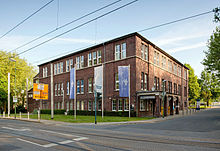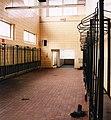Zollverein colliery, shaft 4/5/11
| Zollverein colliery, shaft 4/5/11 | |||
|---|---|---|---|
| General information about the mine | |||
|
Aerial photo of the Zeche Zollverein 4/5/11 (1934) (with markings) |
|||
| Mining technology | Underground mining | ||
| Information about the mining company | |||
| Operating company | Family Haniel Phönix AG for mining and metallurgical operation Gelsenkirchener Bergwerks-AG |
||
| Start of operation | 1893 | ||
| End of operation | 1967 | ||
| Successor use | ZukunftsZentrumZollverein - Triple Z - start-up center | ||
| Funded raw materials | |||
| Degradation of | Fat coal (hard coal type) | ||
| Geographical location | |||
| Coordinates | 51 ° 30 '13 " N , 7 ° 3' 5.6" E | ||
|
|||
| Location | Katernberg | ||
| local community | eat | ||
| Independent city ( NUTS3 ) | eat | ||
| country | State of North Rhine-Westphalia | ||
| Country | Germany | ||
| District | Ruhr area | ||
Zeche Zollverein Schacht 4/5/11 is a mine on Katernberger Straße in Essen-Katernberg . It is located about two kilometers north of today's Zollverein World Heritage Site (shaft 12) and was the third of a total of five shafts of the Zollverein colliery to go into operation. Fat coal (hard coal) was extracted from shaft 4/5/11 between 1893 and 1967 .
Mining history (1893-1967)
Construction of the pit 4/5
The construction of the mine was preceded in 1891 by a trade with the Catholic St. Joseph community in Essen-Katernberg. The church owned the 17,000 m² area of the later mine and was planning a cemetery there. The Zeche Zollverein compensated the community with 20,000 marks and a replacement piece of land and bought the site.
Shaft 4 was sunk in the same year . There, under a 129-meter-thick layer of marl, lay the so-called “Gelsenkirchener Saddle”, in which coal seams and rock lay folded up almost vertically. The steep storage provided the miners with the advantage that the coal that had broken out fell into the mine wagons almost by itself via metal chutes . At the same time, however, a lot of harmful dust and dirt was created. Under these conditions, around 2,900 employees began extracting coal from shaft 4 in 1893. One year later, the weather shaft 5 was sunk and a coal washing plant was built, and a coking plant was built in 1895 .
Modernization and construction of shaft 11
After the First World War , the owners of the mine, the Haniel industrial family , handed over management to Phönix AG for mining and smelting . Thus prevented the Haniel that their hitherto purely family in the course of socialization nationalized was.
Under the direction of Phönix AG, the colliery, which was meanwhile in need of renovation, was enlarged and modernized for around 1.3 million marks. In 1922, this included the sinking of a new shaft with double extraction (shaft 11), through which the maximum output per day could be increased to 4,000 tons of usable coal from 1928.
In addition, workshops, an administration building with a wages hall, a wash house and a hoisting machine house were built. The 4/5/11 coking plant was taken out of service in return.
Cessation of coal production
The modernization of shaft 4/5/11 was followed by a radical rationalization process during the economic crisis. The mine went on in 1926 in the Vereinigte Stahlwerke AG ; the Haniel family had previously exchanged the mine for shares in this newly founded AG. In the course of rationalization, coal production was stopped in shaft 4/5/11 in 1932, and from then on coal was only pumped centrally to shaft 12. The coal extracted from shaft 4/11 was transported underground for extraction. The coking plant was demolished, the weather shaft 5 was demolished and filled.
During the Second World War , shaft 4/11 was hit hardest by the five shafts of the Zeche Zollverein. The winding machine house and carriage circulation of shaft 4, the wage hall and the magazine were hit during a bomb attack. The last damage of the war could not be repaired until 1956 in the wash house of shaft 4/11.
Shutdown
After the war, Zollverein became part of Rheinelbe Bergbau AG, which was supposed to make mining the engine of the economic miracle . For this purpose, coal extraction should be mechanized - a project that failed at shaft 4/11 due to the steep storage of coal. On June 30, 1967, the closure of Zollverein shaft 4/11 was announced. Shaft 4 was filled in the same year, shaft 11 remained as a weather shaft until 1991. 1,059 workers and employees were affected by the closure; a social plan was drawn up for them . In 1968 the Zeche Zollverein was handed over to Bergbau AG Essen of Ruhrkohle AG.
Later use (1968-present)
Ruhrkohle AG training workshop
The area and the colliery buildings of shaft 4/5/11 became the central training facility of Ruhrkohle AG . The company set up an apprentice workshop in which up to 1,100 apprentices could be trained in various mining trades such as mine fitters or electricians at the same time. The training center closed in 1994.
Triple Z AG (ZukunftsZentrumZollverein)
Since 1996, the grounds and buildings of shaft 4/5/11 have been used by the Triple Z business and start-up center (ZukunftsZentrumZollverein) . Triple Z AG (public limited company for the promotion of business start-ups) was founded in the same year.
Between 1996 and 2007 the industrial-historical buildings of the Zeche Zollverein were rebuilt and modernized in four construction phases. Today around 90 companies and young entrepreneurs work in the ten preserved buildings.
More pictures
literature
- History workshop Zeche Zollverein eV (2002): From life with coal. On the history of the districts Katernberg, Schonnebeck and Stoppenberg. Eat. Klartext Verlag.
- Zeche Zollverein eV (2008): The series of working environments. The Zeche Zollverein. Sutton Publishing House. ISBN 978-3-86680-320-6 .
- ZukunftsZentrumZollverein Aktiengesellschaft for the promotion of business start-ups - Triple Z (1999): Zukunftszentrum Zollverein. Project idea and development line for the Essen start-up center. Documentation.
- ZukunftsZentrumZollverein Aktiengesellschaft for the promotion of business start-ups - Triple Z (2006): 10 years Triple Z.
Individual evidence
- ^ History of the parish of St. Joseph: Pastor Joseph Schüller, April 17, 1890 to January 22, 1892 . Website of the parish of St. Joseph in Essen-Katernberg. Accessed January 24, 2013.
- ↑ ZukunftsZentrumZollverein, public limited company for the promotion of business start-ups - Triple Z: 10 years Triple Z , 2006, p. 11
- ^ Zeche Zollverein eV: The Zeche Zollverein / series of working environments. Sutton Verlag, ISBN 3866803206 , p. 27.
Web links
- Description of this sight on the route of industrial culture
- Website of Triple Z AG in Essen-Katernberg
- Rhenish industrial culture







